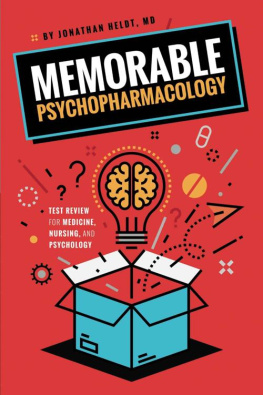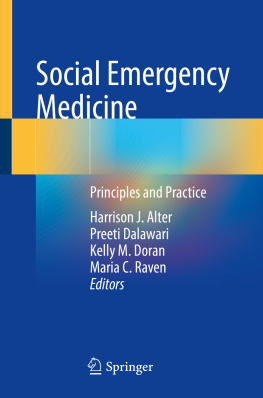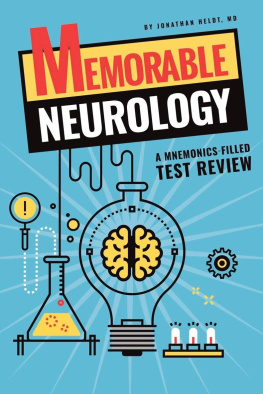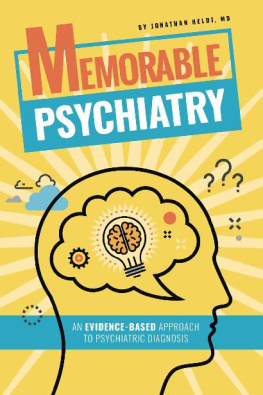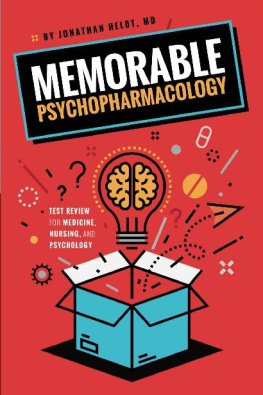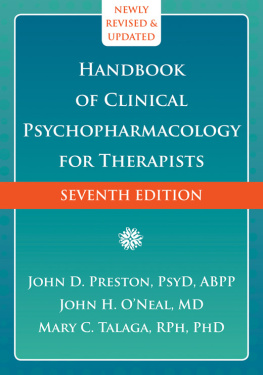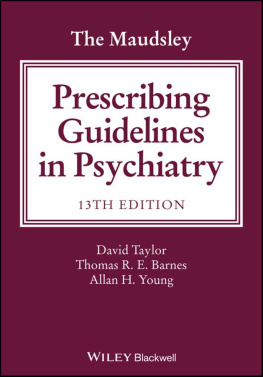Memorable
Psychopharmacology
Jonathan Heldt, M.D.
Also available from the same author:
Memorable Psychiatry
Memorable Neurology
The content of this book is not intended to be a replacement for proper medical training, nor is it intended to substitute for professional medical advice, diagnosis, or treatment. Always seek the advice of your physician or other qualified health provider with any questions you may have regarding a medical condition.
Editing and behavioral consultation provided by Juliane Heldt, BCBA (Board Certified Behavior Analyst) .
Copyright 2017 Jonathan Heldt. All rights reserved.
Revision 1.5. Last revised January 18, 2021.
ISBN: 1535280344
ISBN-13: 978-1535280341
DEDICATION
To Dr. Aubyn Fulton . Thank you for introducing me to the wonders of the human mind and for setting the standard of courage to which I continue to aspire.
CONTENTS
Acknowledgments | i |
| Introduction | |
| Neurotransmitters | |
| Antidepressants | |
| Antipsychotics | |
| Mood Stabilizers | |
| Anxiolytics | |
| Analgesics | |
| Stimulants | |
| Antidementia | |
| Recreational Stimulants | |
| Recreational Depressants | |
| Hallucinogens | |
| Cannabis and Others | |
| Drug-Drug Interactions | |
| Other Modalities | |
| Final Review | |
ACKNOWLEDGMENTS
A world of gratitude to Dr. Frank Randall , who supported me in starting this project. Without him, this would not have been possible.
Special thanks to Dr. Katrina DeBonis , who generously applied her
knowledge and expertise to the crafting of this book.
1 INTRODUCTION
Psychopharmacology can be daunting, but it doesnt have to be. Unlike other fields of medicine like cardiology or endocrinology, which tend to involve processes that are easily visualized and follow a logical order, the concepts in psychopharmacology can seem random, illogical, and abstract. This can lead to frustration or boredom on the part of the learner.
This book aims to correct that. It pursues the goal of making the information stick with reckless abandon. It is shameless in its use of mnemonics and other memory aids. It wants to, and believes it can, make studying psychopharmacology fun. This approach should make the book helpful to healthcare providers from various disciplines and at various stages of training (including medical students, physicians, nurses, pharmacists, psychologists, physician assistants, social workers, and others). The only prerequisites are a basic knowledge of physiology (including organ systems and cell biology), neurology (such as action potentials, synapses, and the autonomic nervous system), and pharmacology (agonists, antagonists, half-lives, and the like).
Well begin with a quick overview of neurotransmitters. From there, we will go over the prescription medications used to treat common mental illnesses such as depression, bipolar disorder, and schizophrenia. We will then discuss recreationally used drugs, including how to recognize the clinical syndromes they produce and how to treat cases of substance abuse. Finally, we will finish with a brief overview of non-drug treatment options for psychiatric disorders.
Before we start, it can be good to remind yourself of exactly why you are sitting through this material, especially if you arent planning on becoming a psychiatrist. There are a few reasons. First, the vast majority of psychoactive drugs are being prescribed not by psychiatrists but by doctors, nurse practitioners, physician assistants, and healthcare professionals in other fields, with primary care forming the bulk of that. Therefore, its important for all prescribers to have a solid foundation in the subject to be able to practice responsibly. Second, even if you will not be prescribing psychiatric medications, you will surely encounter patients using psychoactive substances (whether prescribed or not). And finally, being able to talk knowledgeably about brain stuff is always popular at parties.
While studying, look for the following boxes to identify high-yield concepts! You should remember these well for both boards and wards.
Concepts in boxes are particularly high-yield ! An easy way to remember them will be in italics below. |
Finally, a warning that the language in this book may occasionally be a bit salty. While every effort has been taken to avoid unnecessarily offensive language or concepts, certain mnemonics simply do not work in a more sanitized form. In addition, we should note that nothing in this book is intended to disrespect or trivialize the experiences of people suffering from mental illness. The hope is that, by making the information as memorable and accessible as possible, we can be better equipped to provide the best quality of care for our patients.
If youre short on time , you can fly through the chapters reading only the boxes . Try to come back later to make sure you understand any complex concepts . |
Now, lets begin

2 NEUROTRANSMITTERS
Lets start with a discussion of neurotransmitters, which are central to an understanding of psychopharmacology. First, well briefly review basic principles of neurology and pharmacology, then well move on to discussing each of the major neurotransmitters one by one.
SYNPASES
As you will recall from your study of neurology, neurotransmitters are chemicals that transmit signals across the junction (or synapse ) between neurons. Neurotransmitters are stored in vesicles prior to being released. Here is a basic schematic of a synapse:





Slide 2.1. A visual schematic of a neurochemical synapse.
When the first ( pre-synaptic ) neuron is activated, it releases neurotransmitters, which then diffuse across the synapse to activate receptors on the receiving ( post-synaptic ) neuron. This depolarizes the post-synaptic neuron and causes it to fire. A visual representation of this process is found below, going from left to right:


Next page
